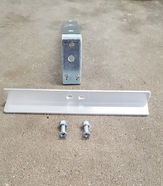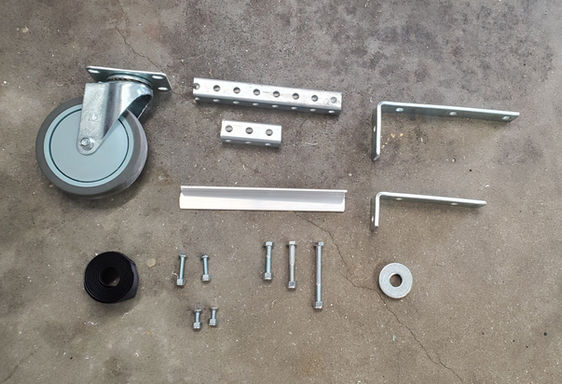DIY Trike Wheel

The DIY Trike Wheel is relatively inexpensive and easy to make. It uses a 5" solid wheel plate caster which is commonly sold at places like Home Depot, Lowes, etc. I have found that this plate caster doesn't flutter even at speeds close to 20 MPH. The DIY Trike Wheel is ideal for road races or on rough urban terrain with sidewalk cracks, potholes, etc.
It also works on moderate nature trails, but not as well as a 6"x2" pneumatic tire (Nature Trike Wheel). But this larger plate caster will flutter on smooth surfaces. Therefore, the 5" solild wheel performs best overall. Everything is a tradeoff.
The trike wheel is positioned as close to the feet as possible in order to increase maneuverability in tight spacers and to enable opening doors. I have found 5" to be a sufficient size front wheel for wheelchair users who can comfortably wheelie. The attachment weights approximately 4 lbs and is secured by an interlocking design combined with velcro straps. I find it to be surprisingly secure.
The DIY Trike Wheel design fits my TiLite TR with the footplate about 2.5" above the ground. The design can be modified to fit footplates of similar solid construction. The zinc corner brackets are suitable for moderate weight and uses. For more heavy duty applications, the Right Angles should be reinforced to prevent the metal from bending.
Fabrication Photos
DIY Trike Wheel Stock List
-
5" Solid Plate Caster with no brake ($21).
-
(2) 8"x 1.25" Corner Brackets (2x$8=$16).
-
(1) 8"x1"x1" punched Zinc square tube section ($8).
-
(1) 3"x1'x1" punched Zinc square tube section ($3).
-
Verco 1.25" wide adhesive strip (bottom).
-
Velcro 1.25" wide nonadhesive strip (top).
-
3" 5/16 bolt and nyloc nut.
-
2.5" 5/16 bolt and nyloc nut.
-
1" 5/16 bolt and nyloc nut.
-
Large washers with I.D. of at least 5/16".
-
10"x 3/4"x3/4" aluminum angle iron.
-
(2) 1"x 1/4" round head machine screws and nyloc nuts.
-
(2) 3/4" x 1/4" flat head machine screws and nyloc nuts.

.png)






















